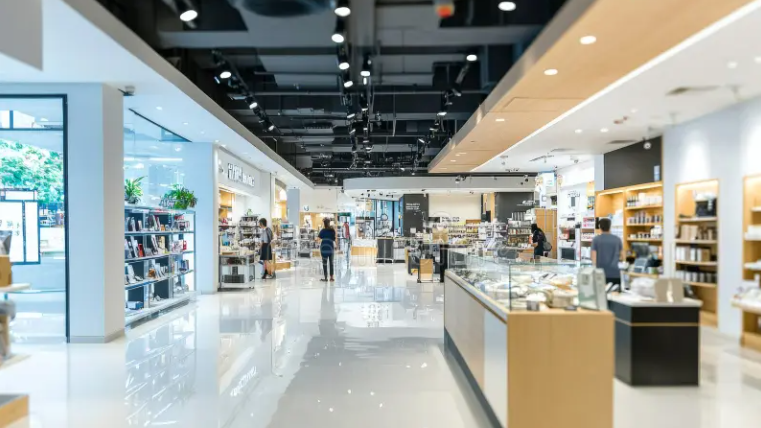Even with the increasing projection of e-commerce of around 90 trillion in revenues by the year 2024, Retail shop remain intact as a vital channel for consumers as it provide the touch of the brand that the consumers have purchased. It has remained clear that physical stores still represent a massive share of sales that is eighty-five percent of the total share of sales by volume. It has therefore been safe to say that there is still a great relevance of physical such as brick and mortar stores. And, retail stores are now no longer such places which the only purpose is selling; they are more as the places where people go in order to be loyal to a certain brand and for a purpose of making sales. It has been clear that the job of retail managers has changed tremendously in this omnichannel world making it a necessity for them to find a balance on the customer’s enjoyment, workflow and stocks in order to be able to compete in the market. See how retail market looks like is given below image

The Alarming Challenges Retailers Face Today
There are still retail stores that are perhaps the ones that assist enforce foot traffic into shops. However, the role they serve is beginning to be put in jeopardy. In this challenge, there are issues of shrinkage and other inefficiencies that are likely to erode profit margins. The issue of shrinkage alone is enormous with the retail shoplifting losses across the globe being reported to be almost dollar 100 billion on yearly basis. On average shrinkage in 2021 for retail was 1.38% of total sales for the sector which meant huge losses when it came to the amount of sales made by retail shops.
However, The other challenges retailers face especially those in luxury sectors is that they are faced by supervision vulnerabilities, whereby the shrinkage rates in these high-end shops around 3-4% which is an annual billion-dollar loss. On top of that, store managers deal with ineffective processes such as the lack of visibility of the poor inventory, product placement and a manual inventory when retrieving items, which costs these kinds of businesses millions every year.
With the invention of e commerce and omnichannel strategy where customers want a singular experience and hence are loyal to the firm allows retail managers to juggle multiple operations for example inventory, store layout, employees, customers, which should be a focal point for retail stores. This situation needs a significant answer which will help to overcome these adversities which would ease up the retail sector. With that being said, however, it seems leaving the possibility of shopping online is not appealing to most people which is demonstrated by the image below-

The Solution: A Perfect Blend of Technology
Enter a powerful combination of computer vision, data analytics, and Generative AI (GenAI)—a game-changing trio that promises to revolutionize retail management.
- Computer Vision: Smart cameras equipped with computer vision track inventory in real time, monitor product placements, detect misplacements, and identify high-traffic areas to optimize store layout and customer flow.
- Data Analytics: Advanced analytics provide actionable insights into customer behavior, sales trends, and operational bottlenecks, enabling data-driven decisions to increase efficiency, retail store audit reports, and boost sales.
- Generative AI (GenAI): GenAI can analyze large datasets to predict future trends, optimize store layouts, and generate personalized marketing strategies, ensuring that every corner of the store works towards maximizing customer engagement and revenue.
Together, these technologies create a seamless system that transforms traditional stores into intelligent ecosystems. By connecting every part of the retail operation, from inventory management to customer interaction, these technologies enable stores to operate in real-time, adapting quickly to changes in consumer behaviour and operational demands.
How These Challenges Can Be Solved
Imagine a retail store that works smarter, not harder. Here’s how the combined force of computer vision, data analytics, and GenAI can solve everyday retail problems:
Inventory Management
Traditional inventory tracking systems often fail to provide real-time visibility, leading to stockouts, overstocking, and theft. With computer vision, smart cameras continuously monitor shelf stock, alerting the store manager to low-stock products, misplaced items, or high-traffic areas that need immediate attention. Managers no longer need to rely on manual counts or make educated guesses about inventory status. Instead, they can access accurate, real-time data that drives smarter decision-making.
Optimized Store Layout and Customer Flow
One of the biggest challenges faced by retail store managers is ensuring that the layout is optimized for customer flow and engagement. With advanced data analytics, retailers can track customer movements and identify high-traffic areas. The data reveals which displays attract customers and which areas are underperforming. Using this information, store managers can reorganize the layout, reposition products, and implement promotional displays that capture customer attention and drive sales.
Predictive Marketing and Sales Strategies
Through GenAI, retailers can predict upcoming trends, understand consumer preferences, and tailor marketing strategies accordingly. For example, if the data shows a rise in demand for workout gear, GenAI can recommend stocking certain styles or colors and even suggest marketing campaigns that resonate with target audiences. By leveraging predictive analytics, retailers can stay ahead of trends and increase sales opportunities.
The Benefits Across Operations: Empowering All Stakeholders
The integration of computer vision, data analytics, and Generative AI in retail stores brings significant value to all stakeholders involved—store managers, customers, employees, and even shareholders. Here’s how each group benefits:
Retail Store Manager
- Better Decisions: Use real-time data for promotions, staffing, and product placement.
- Automation: Simplifies inventory checks and stock audits.
- Faster Actions: Alerts for low stock or customer flow issues.
Retailers
- Reduced Losses: AI minimizes theft and errors.
- Improved Layouts: Analytics optimize customer flow and boost conversions.
- Higher Sales: Predict trends and tailor marketing strategies.
Customers
- Personalized Shopping: Get tailored product recommendations.
- Faster Service: Always find popular products in stock.
- Enhanced Experience: Engaging promotions and displays.
Employees
- Increased Efficiency: Save time on stock management tasks.
- Job Satisfaction: Focus on customer service and meaningful tasks.
- AI Assistance: Daily tools improve workflow and reduce workload.
Valiance Solutions is transforming showroom operations across industries by applying its proven expertise from the automobile sector to domains like Luxury, Fashion Retail, and more. With its AI-powered platform, the company addresses challenges at the showroom level, including inventory optimization, customer engagement, and operational efficiency. By building on its success in streamlining automobile showroom processes, Valiance now delivers tailored solutions to luxury and fashion retail, continuously solving similar problems with precision and innovation. Through this approach, Valiance empowers businesses to enhance customer experiences, boost efficiency, and maintain a competitive edge.









